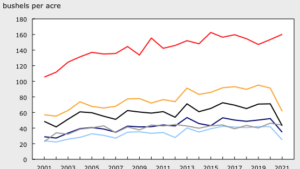The Canadian Seed Growers’ Association and Canadian seed growers have seen big changes in the past two years in the way business is conducted. The 2012 federal budget and the gradual withdraw of the Canadian Food Inspection Agency from the direct inspection of seed crops in Canada necessitated change. A look back at 2014 and the start of 2015 shows how the change was managed, how the change occurred with relative success, and how it continues to evolve._x000D_
_x000D_
Although this change was imposed by government regulations and policymakers, the change was managed in a style somewhat uncharacteristic of modern day industry — government relationships generally prevail in Canada. An Industry-Government Working Group took on the task of coordinating and developing alternative service delivery for seed crop inspection. It started in July 2012 with a completion date of April 1, 2014._x000D_
_x000D_
Collaboration, cooperation and objectivity characterized the work environment for the Industry-Government Working Group. Decisions were made on the basis of what was best for the seed sector and what could get done within the timelines given._x000D_
_x000D_
The solution was the roll-out of an independent, third party inspection model that would be operated by service providers who were authorized by CFIA — essentially a privatization of the inspection model seed growers were accustomed to through the CFIA seed crop inspections of decades past. This was coupled with training and licensing of private seed crop inspectors._x000D_
_x000D_
The inspection model effectively went from 3,500 seed growers communicating with CSGA and CFIA (and vice versa) to 3,500 seed growers communicating with 24 private service providers plus CFIA and CSGA. CSGA, in turn had to communicate with 3,500 seed growers, CFIA, 24 service providers and nearly 300 private inspectors. The new complexity of the communication challenge called for drastic change in data management and data transfer._x000D_
_x000D_
Then and Now_x000D_
_x000D_
A component of this solution was to go as totally electronic as possible in the timeframe available. Prior to alternative service delivery, about 5 per cent of the inspected acres were inspected by licensed, private inspectors. Less than 10 per cent of the inspection reports were being submitted electronically, and that was a result of a pilot project initiated to test the concept of going electronic. Although online applications for seed crop inspection had been available for a few years, in 2013 only 27 per cent of the applications were submitted online._x000D_
_x000D_
The change occurred, and it’s not over yet. In 2014, 89.5 per cent of the inspected acres were performed through authorized seed crop inspection services. For 2014, 24 service providers were authorized; about 200 inspectors were licensed; more than 90 per cent of the applications were submitted online; and 100 per cent of the inspection reports were transmitted to CSGA electronically — a big leap forward from 2013._x000D_
_x000D_
In 2015, the number of authorized service providers increased to 27; the number of licensed inspectors is approaching 300; and about 98 per cent of the applications are received electronically. Additionally, more and more payments for seed crop inspection are also being made electronically._x000D_
_x000D_
Did these changes lead to efficiencies? The answer is a resounding “yes” coupled with a resounding “no.” The fact that alternative service was rolled out in 2014 on nearly 90 per cent of the inspected acres and over 90 per cent of the applications were submitted online demonstrates the efficiencies of going electronic. However, moving from one dominant service provider (CFIA) to 24 in 2014 and 27 in 2015 when coupled with moving from about 200 CFIA inspectors to 300 licensed inspectors demonstrates the inefficiencies (if only in numbers) of going to alternative service delivery._x000D_
_x000D_
How the overall system evolves in 2015 and 2016 will be an interesting measure of how change adapts to meet the needs of the seed sector. What is certain is that the collaboration, cooperation and objectivity seen since 2012 needs to continue._x000D_
_x000D_
All players in the seed sector can benefit from the changes yet to come if we continue to work together to implement future change in the best interests of the entire seed sector. Collectively, not individually, we comprise the seed sector.













